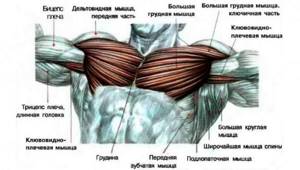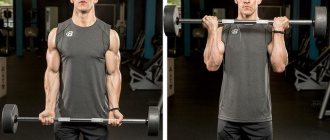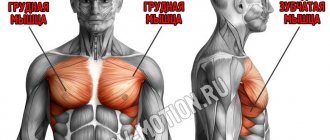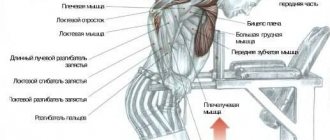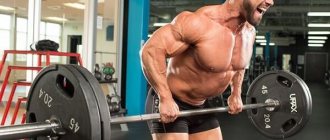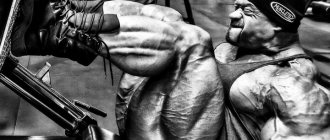Examples of workouts for the pectoral muscles
Now we've reached this point. I hope you remember everything that was written above, because without those moments, the training program is just a set of exercises.
Mass training
Warm up. Seated dumbbell press for 10-12 reps to warm up the shoulder joint
Bench press on a horizontal bench. 2 warm-up 5 work for 4-6 reps
- Incline dumbbell press 1 warm-up and 2 working to failure, but at least 6 times per set
- Push-ups on parallel bars with weights: 1 warm-up, 2 working push-ups to failure, but at least 10 times during the hike
In this workout, we work on all three sections of the pectorals: middle, upper and lower. Since we are working on mass, the weight of the shells will be quite large. In order to lift it we need to spend a lot of effort. But unfortunately, our body does not have such reserves. Therefore, we will not be able to work out as much as possible in a large number of repetitions. And in order to meet the reserve that is available, we will reach failure in each approach. This will make our workout more intense. And if you add proper nutrition to this, your babies will respond to this with significant growth.
Terrain training
Warm up. Seated dumbbell press for 10-12 reps and push-ups for 25-40 reps. The main task is to achieve a burning sensation in the pectoral muscles
Incline dumbbell bench press 1 warm-up and 3 10, 12 and last drop set (approach with weight reduction) 10, 8, and 6 times
Bench press lying on a horizontal bench 1 warm-up and 3 working at 15, 15 and to failure
Lying arm raises 1 warm-up and 3 working for 12-15 repetitions
Two-set (two exercises done in a row is one approach): Horizontal crossover (3 sets of 20 reps) + Dips with body weight 3 to failure
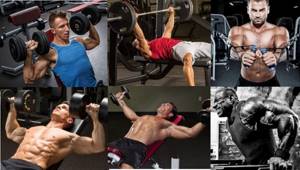
This workout takes a lot of energy and requires maximum concentration on the chest work. All exercises are done under control with an emphasis on working the pectoral muscles. Perform a large number of repetitions in each approach, the main thing is to feel the burning in the muscles. We finish the workout with a two-set of two exercises. In the crossover, we will tire out the lower part of the pecs, and we will finish off with push-ups on the uneven bars.
Workout for Beginners
Warm up. We use any general exercise as a warm-up. Circular movements of the arms, swings from side to side. The main task is to thoroughly warm up the muscles of the shoulder and chest.
Barbell press on a horizontal bench (after 12 weeks, replace it with Barbell press on a bench with a positive incline) 1 warm-up and 3 work for 8-10 reps
Lying dumbbell raises 3 working sets of 10-12 reps
Dips 3 working sets for 10-12 reps (slowly add weight to the belt and do it with it)
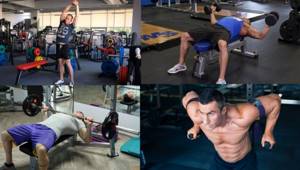
This kind of training is quite enough for a beginner to get comfortable in the gym and work out the exercise technique. As for the warm-up. This approach was not chosen by chance. A beginner has very little energy. And if in the warm-up we press dumbbells over our heads, we will shorten it even more. This way we will warm up our muscles and save energy for hard work.
These training programs will be enough for you to build large pectoral muscles. There are still a few points that I would like to tell you. If your upper chest lags behind, then there is no need to add another exercise to this part. Simply replace the horizontal press with an incline press. The same goes for the bottom.
Good luck to everyone in your training!
READ ALSO:
How to do the bench press correctly
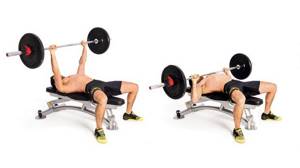
Before we get into the technical details, let's go over the very basics.
- Lie on your back on a bench and retract your shoulder blades, which should remain retracted throughout the exercise.
- Grasp the barbell slightly wider than shoulder-width apart, so that at the bottom of the movement your hands are directly above your elbows. This will allow you to develop maximum power.
- As you inhale, slowly lower the barbell to your chest.
- As you exhale, push the barbell up from your chest, squeezing your palms tightly and looking at the selected point on the ceiling, not at the barbell itself, so you can monitor whether the barbell is following the same path each time.
It would seem, what could go wrong? It's actually not that hard to tear the stabilizing muscles of the shoulder bursa, and it's a very long-healing injury that's better prevented than cured, so it's best to curb your ego and first learn how to safely bench press a barbell on a flat bench with an empty bar and further on increasing.
Mastery comes with experience
To the four basic exercises, after you have mastered them, add at least six others for variety. Then there will be no addictive effect, and the muscles will receive an additional impetus for development.
The exercise is performed with a dumbbell and works to expand the chest. With your knees bent on the floor, lie on your back on the bench (from the back of your head to your shoulder blades), your lower back sagging. We grasp the dumbbell in a vertical position with both hands, bent at the elbows. As you inhale, place your hands with a dumbbell behind your head. As you exhale, we lift up. The movements are slow so as not to injure the joints.
By bringing our arms together in this simulator, we stretch the muscles along the sternum. Sit with your feet shoulder-width apart. The back is pressed tightly against the wall of the projectile. Move your forearms towards the pillows, hold onto the handles. As you inhale, bring your hands together in front of you, exhale. As you inhale, spread your arms to the sides, exhale.
Exercise for the lower and inner parts of the pectoral muscles. We perform hand pinch. Stand in the training area. Bend your arms at the elbow joint, lean forward, grasping the handles of the projectile. As you inhale, pull the handles at waist level and exhale. Inhale and raise your arms to the starting position.
Push-ups are suitable for general development of the pectoral muscles. Next exercise: the lower part of the muscles is involved in push-ups with your hands on the bench and feet on the floor. Conversely, the upper parts of the muscle tissue grow in the position of the hand on the floor and the foot on the bench. Do so-called explosive push-ups: when pushing up from the floor, sharply come off and clap your hands in front of you, return to the position of your hands on the floor. Do all these four exercises without breaks.
For beginning bodybuilders, two workouts a week is enough. Remember that muscles grow in moments of rest and rest. Give them at least two days to grow, four is better.
I repeat, take your time, start with a couple of exercises, do two or three approaches at first. To increase strength, six to seven approaches, muscles - ten to twelve. But you will reach this number of repetitions over time.
Bench press options

01. Classic position.
02. By arching your back, focus the load on the lower pectoral muscles and you will be able to squeeze out more weight. Perform the exercise carefully to avoid lower back injury.
Performing a bench press with an arched back allows you to reduce the trajectory of lowering the barbell and helps to lift heavier weight , since in this case the very powerful lower part of the chest muscles is actively activated. Keep your head and legs motionless. Press your buttocks tightly against the bench.
If you have lower back pain, you should avoid this exercise!
03. By lifting your legs off the floor and holding them in weight, you will completely relieve problems in the lower back and concentrate on working the pectoral muscles.
This position of the legs will avoid excessive arching of the lower back and the appearance of pain in it. This option can be used to reduce the load on the lower group of pectoral muscles, transferring it to the middle and upper bundle of pectoral muscles.
04. By pressing your elbows to your sides, you mainly work the front part of the deltoid muscle.
05. Changing the grip width loads:
- narrow grip : middle of the pectoral muscles;
- wide grip : the outer part of the pectoral muscles.
06. Changing the trajectory of the barbell loads:
— lowering the bar to the lower edge of the chest, you work the lower part of the pectoral muscles;
— lowering the bar to the middle of the chest, you work the middle section of the pectoral muscles;
— lowering the bar onto the clavicular bundles of the pectoral muscle, you work the upper section of the pectoral muscles.
Bench press on a horizontal bench
Pectoral muscles masculinity and becoming
Pumped up chest, back and biceps most attract the aesthetic attention of others. And you can’t take your eyes off the powerful chest
When forming the desired contour, a beginner must know the anatomy of the pectoral muscles. Developed breasts will be achieved by pumping up the pectoralis major and pectoralis minor muscles. Of both of them, the workhorse is the large muscle, while the small one plays a stabilizing role.

The pectoralis minor muscle is located under the major muscle, which rests in a triangle on the shoulders, and with its base in the abdominal muscles, then spreads over the biceps and triceps. All muscles are associated with the deltoids, as well as the latissimus and trapezius dorsi muscles.
Therefore, it is important to follow proper exercise technique. After all, we need to properly form the pectoral muscle, but we can’t stop others from looking sporty either
Chest press
Workout -
Exercises
chest press
When performing a bench press, several aspects should be taken into account, since the angle of the bench directly affects which part of the pectoral muscles will be subject to load. On a horizontal bench, the middle part of the pectoral muscles mainly works; when performing a chest press on an incline bench, the upper pectoral muscles are included in the work, but if you change the inclination to the reverse (head down), a more concentrated load will go to the lower pectoral muscles.
The width of the grip also plays an important role, if the bench press is performed with a barbell, with a wide grip the main load goes to the external bundles of the pectoral muscles, if the grip is made narrower when performing the exercise, the emphasis of the load will move to the middle and inner part of the chest, also to work connect the arm muscles.
Barbell chest press.
It is perhaps one of the most famous exercises for developing the pectoral muscles; with its help you can work out almost the entire area of the pectoral muscles, with the exception of the lower - inner part.
When performing this exercise, you should be quite clear about which part of the pectoral muscles you want to include in the work. The press is performed while exhaling, lowering the barbell to the starting point while inhaling, while breathing should be even, without delay. Hold the barbell symmetrically, at the same distance from the plates, this will allow you to avoid distortions when performing the exercise.
Barbell press with dumbbells.
This exercise allows you to concentrate the load on the outside of the pectoral muscles with maximum efficiency. When performing the exercise, dumbbells should be held parallel to the body, making sure that their movement is carried out synchronously with maximum amplitude at the lowest point. At the top point, on the contrary, you should not fully extend your arms; this will reduce the load on the elbow joints and save strength.
The advantage of the dumbbell chest press is also that, due to the light weight of the plates, you can gain the most smooth weight possible, which gives a good increase in muscle mass. Since in this case the number of repetitions and weight correspond to the optimal indicator.
Block press
Performing a chest press on a block machine is primarily suitable for beginner athletes, due to the fact that here you do not need to accurately calculate the forces as when working with a barbell and you do not need to monitor the parallel work of dumbbells.
The simulator also allows you to quickly add or reduce the load produced, which is simply invaluable if you work according to the “Pyramid” system. The main rule when performing bench presses on a machine is constant control of the weight at all stages of the exercise. The main mistake is that many athletes try to simply squeeze the weight and then throw the apparatus. This approach significantly reduces the effectiveness of training.
If you want to hit your chest muscles with maximum efficiency using the chest press, try changing the equipment you work with each workout. At the same time, do not forget to increase the weight, this way you will use all areas of the chest muscles.
How to Avoid Shoulder Injuries
We asked Dan Roberts, a former athlete, trainer to movie stars, models and other trainers, what to do if you're worried the bench press is taking a toll on your shoulders.
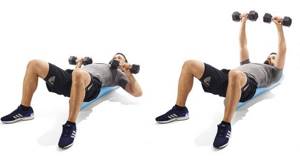
Typically, the answer in this case is that you need to do more pulling movements—face pulls and especially lateral pulls—but that’s not all. If your shoulders are bothering you, focus on performing the bench press itself correctly so that you can perform it safely.
Try this: lie on a soft roller so that it runs along your spine. Concentrate on gripping it with your shoulder blades until you feel like you can practically lift it off the floor, then ask your spotter to give you a pair of relatively light dumbbells—about 50% of the weight of your normal bench press. Using them, perform several sets of five reps, this will put your shoulders in the correct position for the remaining sets of the press.
Tip 1 How to pump up your chest in the gym
Do an exercise with a barbell. This sports equipment is present in every gym
. It is used to build muscle mass and general muscle development at maximum load.
To perform the exercise, lie down on a bench. It should be parallel to the floor surface. Take the barbell with a medium grip. Make sure that during movement the angle between the forearm and shoulder is created at 90°. Raise the barbell up above chest level. This is the starting position for this exercise.
Gradually lower the barbell while inhaling smoothly. Once the bar touches the middle of your chest, exhale and return to the starting position. Remember: movements must be performed smoothly, without jerking.
When bench pressing with a medium grip, use your chest muscles as much as possible. After a second pause, the movement should be repeated. Do this exercise 6-8 times, 4-5 approaches.
Do an exercise with dumbbells
Please note: to maintain constant muscle tension, you should not straighten your elbows completely. Direct the movement towards the center up, avoiding the dumbbells touching
Lie down on a horizontal bench. Hold a dumbbell in each hand. Press your hands to your upper thighs with your palms facing each other.
Gently lift the dumbbells up in front of you to a shoulder-width distance. Press your hands to your chest. Rotate your wrists so that your palms are facing forward. This is the starting position for this exercise.
Gradually lift the dumbbells while exhaling. Lock in this position for a few seconds. As you inhale, lower your arms to the starting position. Make sure that the pectoral muscles are as tense as possible when performing the exercise. Do this movement 8-10 times, 3-4 sets.
Bench press on a horizontal bench

Technique
Starting position: lying with your back on a horizontal bench. The buttocks are pressed tightly to the surface of the bench, and the entire foot is placed on the floor:
- take the barbell with an overhand grip slightly wider than shoulder width;
— take a breath and slowly lower the barbell to chest level, controlling the movement;
- Squeeze the barbell and exhale at the end of the movement.
Performing the exercise
What muscles work
This exercise develops the entire pectoralis major , pectoralis minor , triceps, anterior deltoid, serratus and coracobrachialis muscles.
Exercises for the pectoral muscles - mission accomplished
Let's listen to experienced bodybuilders. They recommend doing push-ups and presses as exercises to work the chest muscles. And use dumbbells, barbells, parallel bars, and a bench as sports equipment.
Before each workout, start your warm-up with push-ups on the floor, chair, or coffee table if you are training at home. And from the bench, sets on parallel bars, if you come to train in the gym. And finish your classes with sets with many repetitions, on simulators. It is better to start strength exercises with stretching and swings with light dumbbells. Increase the loads gradually, take care of your muscles.
Before you develop a program and training regimen for yourself, watch how others do it. On video on the Internet, athletes demonstrate the correct techniques for pumping up the pectoral muscles. Visual experience will serve you invaluable. Because it has been proven: visual memory influences mechanical memory. Take a photo before you start training and compare it with the results over time.
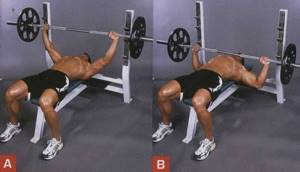
First you need to master the technique of performing four main sets:
- lying arms with dumbbells;
- bench press;
- Incline dumbbell press;
- push-ups on parallel bars.
When working out at home, you can get by with dumbbells, push-ups on a horizontal bar, from the floor on... books, for example. Especially when conditions do not allow it to turn around.
Tip 2 How to make your breasts bigger
Lush breasts attract the attention of men and often serve as the envy of women and the pride of their owner. Its size and shape are established in adolescence, but can be changed later, both for the worse and for the better.
Breast enlargement can be achieved through surgery, special training, or simply as a result of gaining excess weight.

It is possible to radically enlarge the breasts and change their shape only through plastic surgery, as a result of which implants will be inserted under the pectoral muscle. This method allows you to make your breasts 2 or 3 sizes larger, which is almost impossible to achieve in other ways. However, the surgery has many disadvantages, including prolonged breast pain and possible negative health consequences.
Another way to increase the size of one of the most attractive parts of a woman's body is to gain weight. Women's breasts also consist of adipose tissue, the increase of which leads to a change in breast size. For this reason, very plump people usually boast a full bust. However, this method is fraught with obesity and health problems, so only those representatives of the fair sex who suffer from excessive thinness should gain weight.
Vacuum massage also helps to make your breasts bigger - a procedure that increases the flow of blood to the bust. After it, the breasts become much more sensitive, but they look more voluminous and toned, which is why they appear larger. The disadvantage of this procedure is possible pain in the chest area and a short-term effect that lasts from a week to a month. That is why vacuum massage must be repeated after a certain time, preferably in beauty salons.
You can also enlarge your breasts with special exercises that strengthen the muscles that support them. Lie with your back on a bench or stools placed one behind the other so that your knees are bent and resting on the floor. Take 1 to 2 kg dumbbells in each hand and spread them apart. Slowly raise your straight arms above your chest, fix their position for a few seconds, and then again spread them to the sides, lowering them slightly towards the floor. Repeat the exercise 10-20 times.
After this, stand up straight without letting go of the dumbbells. Bend your body forward, trying not to bend your back, and perform the “scissors” exercise with straight arms. To get the maximum effect from this exercise, you need to do 2 sets of 50 arm swings.
The next exercise is squeezing your palms in front of the bar. Stand straight, place your feet shoulder-width apart, and press your palms together in front of your chest. For 10 seconds, press your palms firmly against each other, trying to tense the muscles of your chest and arms. Then rest for the same amount of time and repeat the exercise. The total number of repetitions is at least 10.
How to train the pectoral muscles
First of all, we set aside a separate day for training the pectoral muscles. If babies don't grow, it means they don't get enough exercise. You will have to spend more time and effort working on them.
Pectoral muscle training should take place once a week.
Before starting the specialization cycle, we take a rest and do not train the chest muscles for a week, in order to give the muscles a good rest and recovery before hard work.
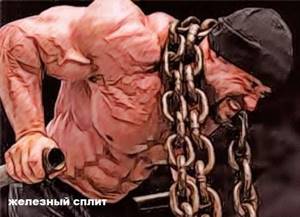
We'll start in a week.
- Bench press 4 sets. We use maximum weights and work to failure.
- Dumbbell bench press at an angle, upside down. 4 approaches. Maximum weights and failure.
- Dips 3 sets of 10 reps. If you can’t do 8 repetitions at first, do as many as possible. If you do more than 10 reps per set, use additional weight.
- Dumbbell flyes on a horizontal bench. 4 approaches. Use a medium weight, trying to work the muscles as much as possible.
- Pullover. We perform this exercise at the end of the workout using average weight. 4 approaches.
You can work with this program for 3-4 months. It all depends on your body. As soon as the weights stop growing, we change the program, but not earlier than after two months.
For ectomorphs: rest between sets for about 2 minutes. Number of repetitions 6-8. If you don’t have time to recover in a week, and at the next workout the working weights drop, alternate: one week you train the pectorals heavily, the next with light weights (50-60% of the working weights).
Read more about alternating training in the article “Periodization in Bodybuilding“.
For mesomorphs: rest between sets from 40 seconds to 1.5 minutes. Reps: 8-10.
For endomorphs: increase the number of repetitions in each exercise to 12-15.
Training the pectoral muscles should be done at the beginning of the week for better recovery.
Another good way to sculpt your pecs and make them grow is through strength training. Perform bench presses for strength for a month: 5-10 sets of 1-5 repetitions. There is no need to do any more chest exercises. After a month, return to your regular bodybuilding workouts.
If you have chosen a good split for yourself and do not want to change it, then do 2-3 light chest workouts, and then return to regular training. Such changes in training will help to avoid stagnation and overcome the “plateau”.
Bench press with head down
A very specific exercise that is often very rarely seen in regular gyms. Despite this, this exercise is the most effective way to work the lower chest and give definition to these muscles. This exercise is rare only because not all benches are equipped with a position in which the lounger drops below parallel. A way out of this situation can be to use a board for abdominal crunches, having previously weighed the legs with weights from pancakes and dumbbells.

Negative Bench Press
The exercise is performed in a classic manner, with the barbell lowered to the very bottom of the chest, and the barbell being pushed out using the muscles of the lower chest. In this exercise there is no need to chase weights; it is recommended to work with fairly moderate weights, amounting to 60% of the working maximum for one repetition.
Isolation exercises
For athletes who have been training for less than 2 years, only basic exercises are recommended. Experienced athletes must supplement training aimed at pumping up the pectoral muscles with isolating exercises, which help refine the shape of the muscles and shape the relief.
Dumbbell raises
Among the basic exercises that help pump up the pectoral muscle, the bench press is unrivaled.
Among the isolating exercises, the “dumbbell fly” exercise is equally important. It involves the only joint - the shoulder, which means that the force is concentrated on the chest
Initial position:
From the “sitting on the edge of the bench” position (legs bent at the knees), lean back, i.e. lie on a bench, raising your arms bent at the elbows with dumbbells so that they are above your shoulders.
Technique:
- As you inhale, spread your arms to the sides to the extreme point, fix the position for a second, feeling a pleasant stretch in the chest muscles (but not pain).
- Taking a smooth breath, bring the dumbbells together until they touch, then pause again.
Recommendations:
To avoid injuring the elbow joint, do not fully extend your elbows. Do not arch your back in order to maximally pump up the pectoral muscles and not redistribute the load on the lumbar region. To pump up your chest, use dumbbells of moderate weight.
Pullover with dumbbell
It's not the most effective chest exercise because it doesn't allow for the use of heavy weights to stimulate the muscle fibers, but it's a must-have for beginners looking to build chest muscles because it expands the chest.
Initial position:
Place the dumbbell near the bench with its end up (at the head), on which you lie with your upper back. Hold the dumbbell with both hands at the top, bending at the waist. Fully straightening your arms, lift the projectile above your chest.
Technique:
- Lower the projectile behind your head while inhaling, keeping your elbows slightly bent.
- Along the same trajectory, as you exhale, return the dumbbell to its original position.
Recommendations:
- You can pump up your pectoral muscles by doing the exercise slowly, without jerking.
- To prevent injury to the elbow joint, do not fully straighten your arms at the elbows at the top point.
- Try to lower the dumbbell as low as possible to allow the pectoral muscle to stretch.
In addition to those discussed, there are exercises that help pump up the pectoral muscles in exercise machines.
Reduction of arms (simulator “Butterfly”)
The exercise machine is extremely popular among beginner athletes who are still afraid of lifting a barbell. Despite the many varieties, the principle of operation is the same for all of them. To build muscles on a machine, you do not need special training. It's easy to do and there's no risk of injury.
Initial position:
Sitting on the bench, you need to straighten your back and press it tightly against the machine. Place your feet comfortably shoulder-width apart and rest your forearms on the pillows.
Technique:
- After taking a deep breath, bring your hands to touch in front of you, and exhale.
- As you inhale, slowly return your arms to the starting position.
Recommendations:
- To pump up your muscles as much as possible, try not to remove the load from your chest while raising your arms.
- Don't lift your back off the bench.
Bringing hands through the upper blocks in a crossover
The exercise machine allows you to pump up the lower and upper parts of the pectoral muscles.
Initial position:
Hold the handles, stand between the racks of the machine, lean forward a little, bend your elbows slightly.
Technique:
- With both hands, simultaneously pull the crossover handles to your waist, exhaling at the extreme point.
- Slowly return your arms to the starting position, taking a breath.
Recommendations:
The legs and back remain motionless throughout the entire exercise. Only the hands work.
{videochart}83825.87cc5fbb01ac928a508175da4d1e{/videochart}
Video: Master class chest muscle training
List of effective exercises for the gym
Dumbbell Bench Press

Helps increase the size of muscle fibers. Perform in the following sequence:
- Lie with your back on a bench and take dumbbells in your hands. They move them apart, hold them suspended, palms facing up.
- The shoulder and forearm form a right angle. At the exit, lift the dumbbells up.
- Then they are immediately lowered, palms facing each other.
- Place your hands on your hips and assume a sitting position.
You need to lift the weight faster than return it. When lifting a weight, the shoulder blades move away from each other, and when lowering, they move together.
Dumbbell raises in different directions
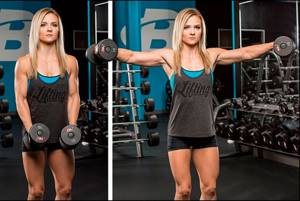
Dumbbell lateral raises
A hard but effective exercise for the pectoral muscles for women in the gym, which can be performed on a bench:
- Lying on a bench, hold dumbbells in your hands, then raise them up in front of you, palms facing each other.
- As you inhale, lower your arms in different directions, trying to stretch the pectoral muscles, but moving only your shoulders.
- As you exhale, bring your arms together in a hugging motion.
When performing the exercise, your arms should not sag much - you should strive to be parallel with the floor.
Bench dumbbell press
Performed to improve the condition of the upper pectoral muscles. It is advisable to use a Roman chair or bench, the angle of which can be raised. Perform in the same way as a dumbbell bench press.
Seated dumbbell raise

Seated dumbbell press
This exercise for the pectoral muscles for girls in the gym is performed as follows:
- Sitting on a bench, straighten your back and place your feet shoulder-width apart.
- The shoulder blades and shoulders are pulled back, the stomach is pulled in.
- Take dumbbells in each hand and lower them down.
- As you exhale, pull the weight up to shoulder level.
As you inhale, return to the starting position.
Bench press
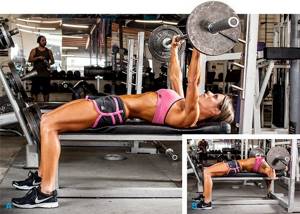
Bench press
To perform this exercise, you need to choose the appropriate weight. The trainer will advise you to do the bench press from a neutral position or at an incline position. The tactics are as follows:
- The girl lies down on the bench and sucks in her stomach. Your back should be strictly straight, your feet should be flat on the floor.
- Hands are placed on the bar, forming a perpendicular angle with the elbow to the floor.
- The hands are turned forward, while inhaling, the barbell is lifted, fully extending the elbows.
- Hold the position for several seconds, then, as you exhale, return the projectile to its place.
Exercises with a barbell are given a minimum number of approaches and repetitions.
Crossover block exercise
This exercise will require adjusting the upper block. It needs to be brought to the chest, as with dumbbells. Movements should be smooth, without jerking, and not too light. The weight of the load being lifted should be felt.
Dips
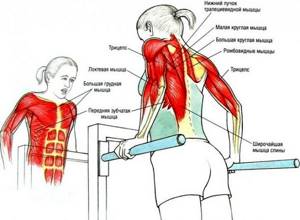
Muscles used during dips
A complex and effective exercise is designed for those who already have experience in working out muscle fibers in this way. Dips work well on your shoulders and triceps by bending and extending your arms under your own body weight. Do it like this:
- After jumping onto the machine, you need to keep your body in an upright position with your arms straight. The legs are bent at the knees.
- The elbows are pulled back and they try to support the body with them, the body tilts slightly upward.
- Exhale and tighten the body; if this is difficult, you can straighten your arms at the top.
- As you inhale, lower yourself down and feel the muscles in the chest area stretch.
Bench press
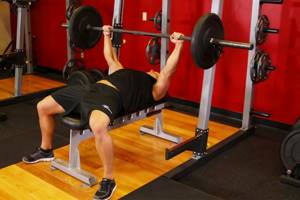
This type of training is key if you want to actively develop the muscles of the pectoral area, as well as the large and small muscles of the chest, triceps, deltoid and serratus brachii.
How to do the exercise:
- We take a lying position with our backs on the bench, with the entire surface of the foot adjacent to the floor, and the buttocks pressed tightly against the bench;
- We grab the bar from above, while placing our hands at a distance slightly greater than shoulder width;
- inhale - the weight is gradually lowered to the chest, with strict control over the movements;
- exhale - from the lowest point to which the barbell has dropped, and as it slowly rises.
Tips for doing the exercise:
For a more powerful effect from this exercise, we recommend using the following techniques:
- stabilize your wrists by firmly grasping the bar with both hands;
- press the back of your head firmly against the bench and tuck your chin in;
- You can reduce the amplitude of lowering the weight by arching your back. This is necessary for the active use of the lower chest muscles;
- ensure that the gluteal area is firmly pressed against the surface of the bench throughout the entire approach;
- Stability of the posture is ensured by the feet. It is extremely important that they press their heels firmly into the floor during the exercise.
Safety when performing the exercise:
This exercise can be dangerous for the trainee if some points are performed incorrectly:
- The thumb of the hands should be opposite the other fingers. This way the grip will be stronger, forming a kind of lock;
- The position of the thumb ensures safety when holding the barbell. If it does not fully wrap around the bar, the likelihood of the bar falling onto your chest or face increases.
Bench press options
- Option with arched back. This type of bench press will reduce the amplitude of the barbell’s descent, which means you can pick up more weight. It is important to carefully monitor all movements to avoid injury to the lumbar region. This option implies complete immobility of the head, legs and completely pressed buttocks. If you feel pain in the lower back, you should immediately stop doing the bench press.
- Different grip options based on the distance between hands:
- a narrow grip is aimed at loading the muscle groups of the middle chest area;
- a wider grip is designed to work the outer chest muscles.
- A different trajectory when lowering the weight allows you to focus on different muscles:
- lowering to the lower chest area - increasing the load on the lower muscle area;
- to the middle of the chest - working out the muscle groups of the middle section;
- lowering closer to the clavicular region gives more emphasis on developing the upper chest muscle group.
- It is possible to perform this exercise with your legs raised. This will relieve unnecessary tension from the lumbar region and will lead to greater stress on the upper chest muscle groups.
Video “Bench Press”:
Next
Chest Dumbbell Bench Press

Anatomy of the chest muscles
The pectorals are one of the three largest muscle groups. They are located above the abdominals.
The main muscles can be identified:
Pectoralis major muscle. This is the largest muscle of this group. It is on its development that we will spend 90% of our efforts. Conventionally, it is divided into three zones: upper (least developed and weakest), middle (largest zone, which gives volume to the breasts), lower (anatomically the strongest).
Small chest. Located under the pectoralis major muscle. Its development will help increase breast size, making it more massive.
Their function is to bring the arm to the body. That is, if we spread our arms to the sides, then in order to bring them together in front of us we will connect the pectoral muscles.
And there are also secondary muscles, but this does not mean that they are less important than the main ones:
Serratus anterior muscles. They help the rhomboids bring the shoulder blades together, thereby stretching the pectoralis major muscles more.
Subclavius muscle. Responsible for the movement of the collarbone.
Good development of this muscle group increases the volume of the chest. Such a change will visually affect the breasts themselves, visually making them larger.
